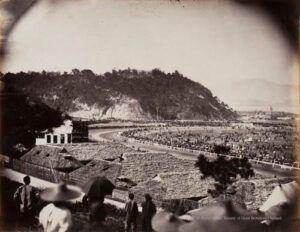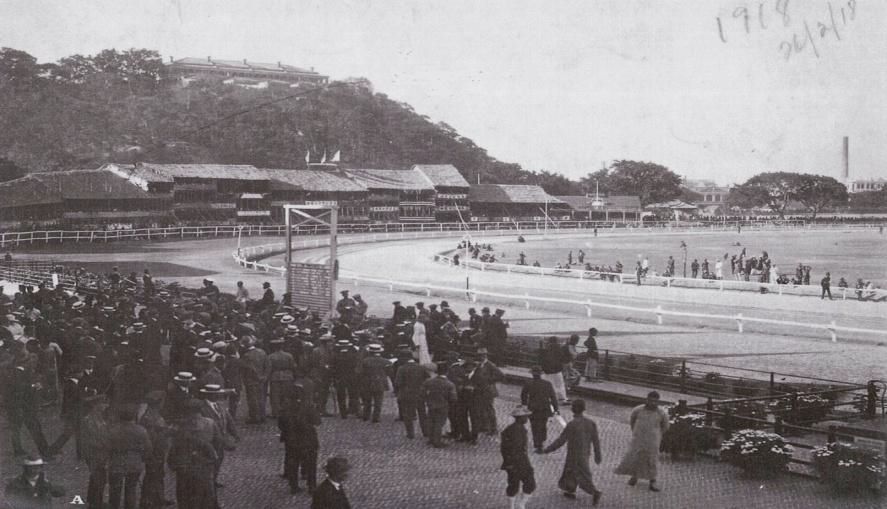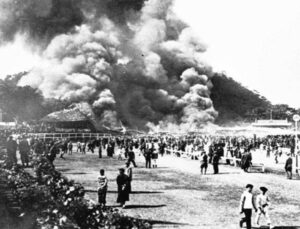The Happy Valley Race Course Fire of 1918
Roy Eric Xavier
April 2012
This article appears in the website Far East Currents, created by Dr Roy Eric Xavier of University of California Berkeley, who is devoted to research on the Portuguese community in Hong Kong. Dr Xavier has kindly given permission for it to be reproduced here.
Prelude
The late winter of February 1918 in Hong Kong was unusually windy and heavy with anticipation. The war in Europe was in its final months, and the effect on trade, now shifting to the Americans and Japanese, was a cause for concern.1
Among superstitious Chinese and Europeans, two small earthquakes on the 13th and 14th of February, and an outbreak of spinal meningitis leading to 968 deaths, were ominous signs for the future. Just a few weeks earlier a monsoon had damaged the dock and beach area around North Point. Since then no rain was recorded on the island, and as a result, the weather remained dry and unseasonably warm. 2
The dry weather, however, suggested to other residents the coming of spring, and with it the opening of the horse racing season at Happy Valley, a traditional event in Hong Kong since 1864.
The “season” had different meanings to many people. To the government, horse racing meant the appearance of “matsheds”, the temporary bamboo and palm leaf structures licensed and built at the race course by enterprising groups of Chinese, Portuguese, Japanese, Indian, and Swedish families.3
Derby Day 1918
| Olson did, however, order his contractors to put “double uprights” to reinforce the betting and refreshments counter on the bottom floor, expecting, as he stated later, “more of a crush at the counter” that year.16 In No. 6, Olson also allowed the use of charcoal “chatties” for cooking by a Chinese vendor, M.Y. San, but instructed San to have three large barrels of water on the bottom floor, and eight full fire buckets on the upper floor.17 After the morning races ended, Francisco de Paula Xavier, one of the owners of his family’s stand at No. 7, joined several relatives and friends for lunch. They included his stepbrothers José Maria Xavier and Ludovino (Bino) Xavier, and nephews Paulo and Vasco Xavier, who were eighteen and twenty years old, and niece Daria Xavier, who was sixteen. The younger relatives were the siblings of Pedro Xavier, the owner of the Hong Kong Printing Press. They were probably joined by at least seven other members of the Portuguese community from Hong Kong and Kowloon.18 Francisco had instructed his contractor to build a three story matshed for the 1918 season. The ground floor was used for refreshments, which were sold by Chinese employees. The main floor was for pari-mutuel and cash sweeps betting. The top floor, built to only half the size of the lower floor, was reserved for ladies in attendance.19 Cooking was not allowed that day, but a charcoal chatty was used on the bottom floor to boil water for tea. Francisco also stated there was one entrance on the first floor, but none on the top or bottom floors, adding that the doorway was about six feet wide.20 |
The Collapse and the Fire
As the betting period ended and the horses approached the line, the last thing anyone expected was the chaos and terror that was about to unfold. A reporter for the Hong Kong Daily Press gave this eyewitness account:
He stated that those in the infield were …
The Aftermath
… the service was more than a conventional expression of sympathy. It was indeed an outward manifestation of genuine sorrow, not only for the relatives and friends … but also for the hundreds of human beings who have been victims of an appalling catastrophe.36
Recriminations within the Hong Kong government soon followed. Hong Kong’s Coroner noted that:
A member of the Legislative Council further pointed to the:




